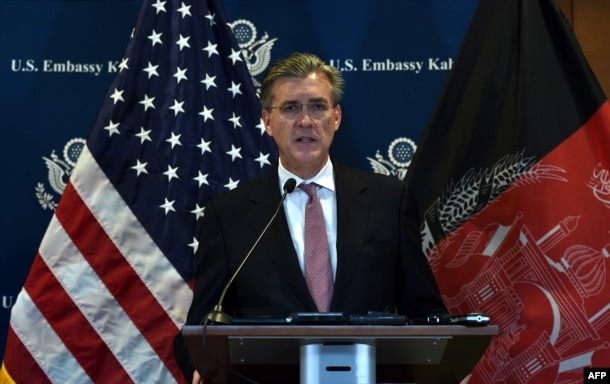US Lawmakers Question Afghanistan Spending

Esha Sarai
VOA News
As the United States prepares to mark 15 years since the start of the U.S.-led offensive in Afghanistan next month (October 7), American lawmakers are questioning the continuing military and humanitarian spending aimed at trying to end the war and stabilize the government.
Members of the Senate Foreign Relations Committee expressed concerns over the progress of the war, and the effectiveness of programs aimed at rooting out corruption.
Richard Olson, special representative for Afghanistan and Pakistan at the U.S. State Department, said the U.S. gives Afghanistan about $5 billion per year – $4 billion in support of the Afghan national security defense forces and roughly another billion in the form of civilian assistance.

US Special Representative for Afghanistan and Pakistan, Ambassador Richard Olson speaks during a press conference at the US Embassy in Kabul, Dec. 6, 2015.
But Senator Corker of Tennessee expressed his concern that year after year, the U.S. continues to spend similar amounts of money in Afghanistan – the fruits of which may not be immediately seen by the American people.
«They (U.S. people) weigh $10 billion a year ad infinitum…how would you express the value of this to Americans?» he asked the panel.
Donald Sampler Jr., assistant to the administrator of Afghanistan and Pakistan Affairs at USAID, stressed the importance of ensuring order and a certain threshold of quality of life.
«Overlaying that with our national security interests, coming from a military background, ungoverned spaces are the worst [possible thing we could allow to reemerge,» Sampler said. «So supporting the government of Afghanistan and supporting their ability to govern their own space and doing that proactively to prevent insurgencies rather than having to counter them is in my opinion a good investment.»
Senators also discussed concerns that the Islamic State terror group’s influence is growing in the region, through its Afghan affiliate known as the Islamic State in Khorasan Province (ISKP).
«We believe that they have a few thousand fighters 1,500 to 2,500 mostly concentrated in the Nangarhar Province in the east,» Olson said. «They are actively being fought against by the government of Afghanistan and of course our own forces are carrying out airstrikes against them.»
But Olson clarified that the Taliban and Islamic State are not working together in Afghanistan, but instead oppose each other as the Taliban focuses its objectives domestically and Islamic State has a global agenda.
Although the United States has dramatically scaled back the number of American troops in Afghanistan, the U.S. remains deeply involved.
Obama requested $3.45 billion in the 2017 budget to help fund Afghan security forces. He recommended that his successor maintain funding at that level through 2020. U.S. military trainers continue to advise Afghan forces, and U.S. warplanes carry out strikes to help Afghan units fighting on the ground.

